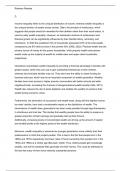Raahavy Rasaiya
1.
Income inequality refers to the unequal distribution of income, whereas wealth inequality is
the unequal division of assets across society. Often, the principle of meritocracy, which
suggests that people should be rewarded for their abilities rather than their social status, is
used to justify wealth inequality. However, an individual's chances of achievement and
financial growth can be significantly influenced by their familial history, schooling, and
inheritance. In 2020 the wealthiest 10% of households possessed 43% of the total wealth,
compared to just 9% held by those in the poorest 50% (ONS, 2022). Physical wealth was the
primary source of money for the poorer households, while property wealth and pension
wealth made up the majority of wealth for middle-class and upper-class households,
respectively.
Inheritance exacerbates wealth inequality by providing a financial advantage to families with
greater assets, which they can use to give substantial inheritances to their children,
whereas less fortunate families may not. They also have the ability to obtain funding for
business start-ups, which may be an important component of wealth generation. Wealthy
families have more access to higher amenity communities with better schools and safer
neighbourhoods, increasing the chances of intergenerational wealth transfer (Hills, 2013).
Wealth also reduces the risk of asset depletion and enables the wealthy to preserve their
wealth during economic crises.
Furthermore, the elimination of succession and wealth taxes, along with the highest income
tax rates' decline, have had a considerable impact on the distribution of wealth. The
transmission of wealth down generations has been made possible through legal frameworks
in inheritance and trust law. This implies that wealthy people have the ability to preserve a
greater proportion of their earnings and gradually build up their fortune.
Additionally, increasing levels of concentrated wealth are driving up the amount of capital
and windfall profits at the highest points of the wealth distribution.
Moreover, wealth inequality is worsened as younger generations more unlikely than their
predecessors to climb the property ladder. This is due to the fact that people born in the
1980s and 1970s respectively had lower rates of home ownership than people born in the
1950s and 1960s at a similar age (Bourquin, 2022). Thus, elderly people get increasingly
wealthy, and half of employed folks generally rent their homes. This could be attributed to
the fact that many of them have relatively substantial pensions.
, Raahavy Rasaiya
Asset inflation, rise in the worth of assets like stocks, bonds, and real estate, has been a
major factor in escalating wealth disparity in the UK. It favours those who already hold
assets by raising the value of those assets, putting a barrier in the way of others who do not
already own assets, and concentrating money in specific areas (Bangham, 2020). Those
unable to purchase a home lose opportunities like growing equity. Similarly, individuals
lacking investments are unable to profit from the appreciation of capital. Additionally, it gets
harder for first-time home buyers to break into the housing market as long as the costs of
housing keeps going up.
Wealth inequality is a significant problem in contemporary countries and is exacerbated by
outright inheritance, legal frameworks in inheritance and trust law, asset inflation, and
younger generations' inability to climb the property ladder, leading to concentrated wealth
and a lack of opportunities for those who do not already own assets.
BIBLIOGRAPHY:
Bangham, G., Leslie, J. (2020). ‘Rainy days: An audit of household wealth and the
initial effects of the coronavirus crisis on saving and spending in Great Britain’
Resolution Foundation.
Bourquin, P., Brewer, M. and Wernham, T. (2022). ‘Trends in income and wealth
inequalities’, IFS Deaton Review of Inequalities.
Hills, J., Bastagli, F., Cowell, F., Glennerster, H., Karagiannaki, E. and McKnight, A.,
(2013). Trends in the distribution of wealth in Britain. Wealth In the UK’, 1st edn,
Oxford University Press., Oxford, pp.10-34.
ONS (2022). Household total wealth in Great Britain: April 2018 to March 2020.
2.
The problem of in-work poverty has become more pervasive in modern society. When an
individual's income following housing expenses falls under 60% of the national average and
is insufficient to cover the cost of living, this is referred to as being in an in-work
poverty (Hirsch, 2018).
While poor income is a major cause of in-work poverty, there is no direct correlation linking
low pay and in-work poverty, with its relationship being multifaceted and complex,
where poorly paid workers are more likely to experience poverty at work. Low income makes




